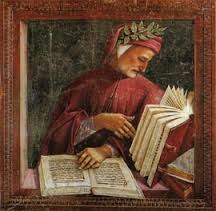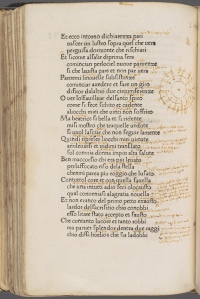The medieval scribe
Before the widespread adoption of the technology of movable type (often conflated, not wholly accurately, with the development of the Gutenberg Press) in Europe in 1450, production of texts was limited to hand-copied manuscripts, usually by scribes; or block-printed editions, often with hand-painted illuminations. Interacting with the material text at the level of production was much more usual than it has become in the era of mechanically-reproduced texts. In Commentary on the Sentences, St Bonaventura set out four ways in which a medieval person might participate in making a book: as Auctor, Scriptor, Compilator, Commentator.
In chapter 1 of the Vita Nuova, Dante sets himself up as scriptor, claiming that he is copying an earlier text (albeit his own):
“In quella parte del libro de la mia memoria dinanzi a la quale poco si potrebbe leggere, si trova una rubrica la quale dice: incipit vita nova. Sotto la quale rubrica io trovo scritte le parole le quali è mio intendimento d’assemplare in questo libello: e se non tutte, almeno la loro sentenzia.”
As we progress through the book, we can see that this is a strategy that allows the author to manipulate the reception of his text, fusing the authority of the so-called ‘original’ (the libello) with the freedom to diverge from an authentic copy of the words in order to clarify meaning (“se non tutte [le parole], almeno loro sentenzia”).
If we take the position that inspiration is divine, or beyond the volition of the individual (“Amor mi spira”, as Dante says to Bonagiunta in Purgatorio 24), then the role of scriptor – mediator rather than originator – is a mode of authorship compatible with Christian humility. Furthermore, by personalising the act of copying or signifying (“Vo significando”), the writing has the potential to become a form of confession, shifting the power for agency and judgment into the hands of the intercessionary recipient of the writing. Writing on Eudocia’s Homerocentones, Francesca Middleton suggests that in such a case, “the author is not figured as someone who can or should retain control over their personal literary expression. Instead, personal experience is transmitted in the hope that others might take control over it and produce new renditions of it – potentially ‘create’ new literature” (Francesca Middleton, forthcoming doctoral thesis, University of Cambridge).
My blog, copying dante, is here.
Illumination
 This section is under construction.
This section is under construction.
See: Oderisi, Purgatorio 11.
Marginalia
This section is under construction.
In his paper The Reader’s Eye: Between Annotation and Illustration, Bill Sherman writes: “In the first few centuries of print culture, readers drew sketches, diagrams, iconic tags and body parts and fully-fledged decorative or illustrative schemes”.
Cornell Fiske 1472 Neumeister, Paradiso 14:

